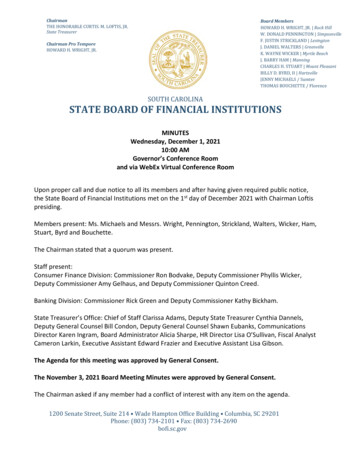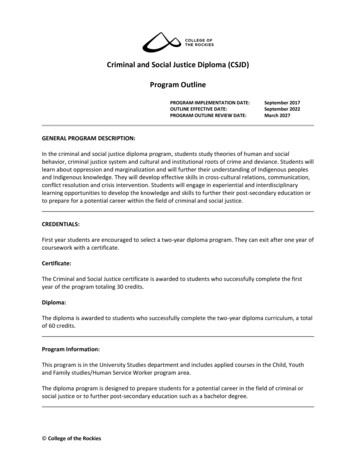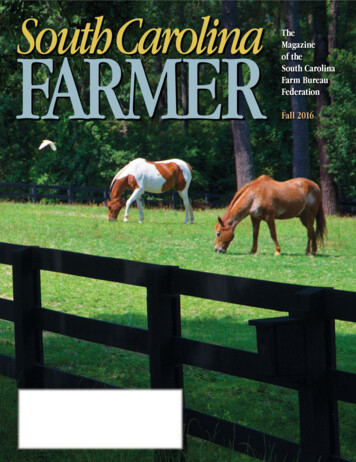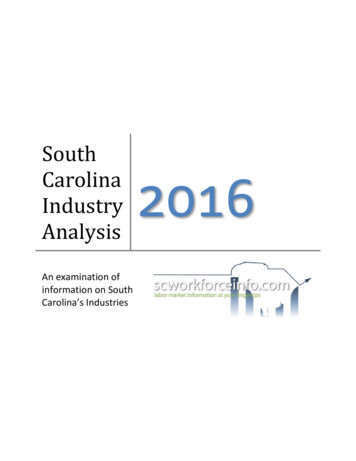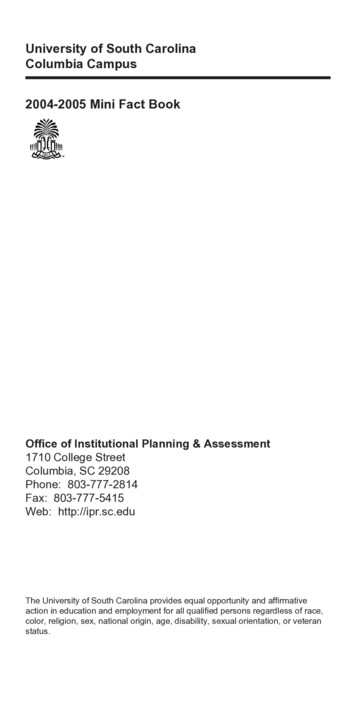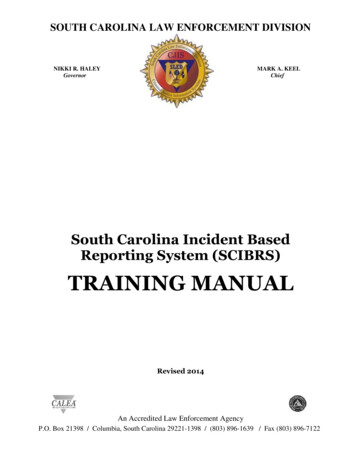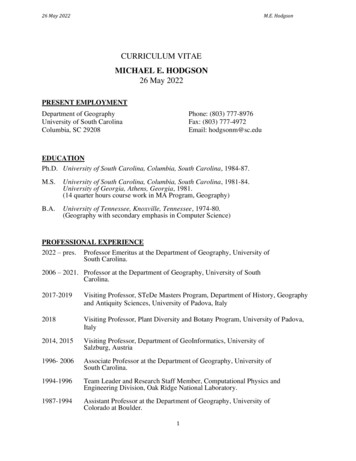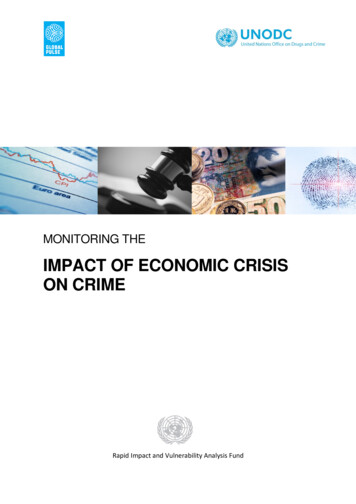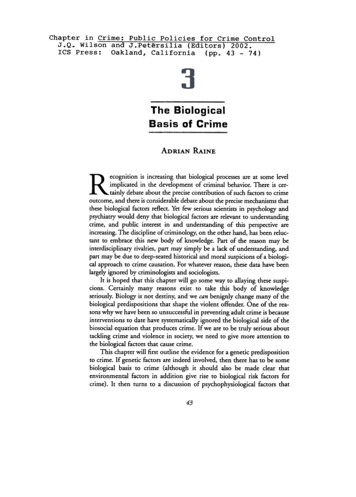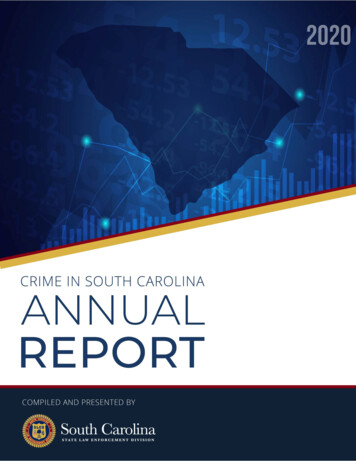
Transcription
Crime in SC 2020
Crime in South Carolina2020PresentedOctober 2021
Compiled and published by:South Carolina State Law Enforcement Division (SLED)Mark A. Keel, ChiefRichard R. Gregory, Assistant ChiefCriminal Justice Information Service (CJIS) DivisionCharles M. Coats, Major, Director SLED CJISNatalie Crosland, CaptainComputerized Crime Information Service (CCIS)Bryan C. Ridgeway, Lieutenant, CJIS - CCIS ManagerSouth Carolina Incident-Based Reporting System (CCIS - SCIBRS) UnitCarolyn Shawen, Trainer/AuditorAlea Washington, Statistical Research AnalystGeographic Information Service (CCIS - GIS) UnitJames Kennedy, Program CoordinatorCover and Chapter art created by:Lara Gorick, Forensic Artist, Special Victims UnitCrime in SC 2020
This report is dedicated to all law enforcement officers—particularly thosekilled in the line of duty while serving the citizens of South Carolina.Sadly, eleven officers died in the line of duty in 2020Beginning in early 2020, the COVID pandemic introduced a unique and invisible threat to front-line,essential workers. While many Americans were able to protect themselves by avoiding others, the dedicated,selfless, brave men and women of law enforcement, both sworn and non-sworn, remained on-duty andcorageously fulfilled their mission of service to others. Some of the officers listed below died as a result ofcontracting COVID while performing their duties.Officer Jackson Ryan WinkelerEnd of Watch January 5, 2020Florence Regional Airport Public SafetyCorporal Michael H. AmbrosinoEnd of Watch July 16, 2020Horry County Police DepartmentCorporal Andrew J, GilletteEnd of Watch February 25, 2020Sumter Sheriff's OfficeLt. Maybelle W. HendricksEnd of Watch August 17, 2020Ridgeville Police DepartmentDeputy Jeremy C. LaDueEnd of Watch April 12, 2020Charleston Sheriff's OfficeLt. Ethan R. KaskinEnd of Watch September 25, 2020Anderson Police DepartmentSergeant Mikkos L. NewmanEnd of Watch June 8, 2020Lee County Sheriff's OfficeOfficer Jacob W. HancherEnd of Watch October 3, 2020Myrtle Beach PDMaster Police Officer Robert J. HallEnd of Watch July 14, 2020Columbia Police DeepartmentSgt. W. Conley JumperEnd of Watch October 20, 2020Greenville County Sheriff’s OfficeCaptain Johnnie Abraham, Sr.End of Watch December 18, 2020South Carolina Law Enforcement DivisionIn addition to the officers named above, we would like to acknowledge the officers whose lives were lost tosuicide. Their service, sacrifice, and the circumstances leading to our loss of them is no less significant. Therewere five reported in 2020.Information regarding deaths in the line of duty was furnished by the S.C. Law Enforcement Officers Hall of Fame.www. scdps.sc.gov/hof 803-896-8199 www.facebook.com/scleohofInformation regarding the officers lost to suicide was furnished by the S.C. Law Enforcement Assistance Program(SCLEAP).www.SCLEAP.org 803-252-2664 24 hr Emergency: 803-737-9000 / 803-896-7000
CONTENTSTable of Contents2020 Law Enforcement Agencies Participating in SCIBRS . 1INTRODUCTION . 2HISTORY, SRS, AND IBRS. 2THEME ORIENTED PUBLIC SITE (TOPS) . 4CRIME RATES . 5CLEARANCE . 5POPULATION DATA . 6INDEX OFFENSES . 11VIOLENT CRIME . 14MURDER . 15SEXUAL BATTERY . 21ROBBERY . 27AGGRAVATED ASSAULT. 30PROPERTY CRIME . 33BREAKING AND ENTERING . 34MOTOR VEHICLE THEFT . 36LARCENY . 38ARSON . 40ARRESTS . 45ADULT ARRESTS. 47VIOLENT CRIME . 49PROPERTY CRIME . 50DRUG LAW VIOLATIONS . 51WEAPONS LAW VIOLATIONS. 52SIMPLE ASSAULT . 53DRIVING UNDER THE INFLUENCE. 54LIQUOR LAW VIOLATIONS. 55DRUNKENNESS . 56ADULT ARRESTEE CHARACTERISTICS . 57ARRESTS BY COUNTY . 58JUVENILE ARRESTS . 105VIOLENT CRIME . 108Crime in SC 2020
CONTENTSMURDER . 109SEXUAL BATTERY . 111ROBBERY . 112AGGRAVATED ASSAULT. 113PROPERTY CRIME . 114BREAKING AND ENTERING . 115MOTOR VEHICLE THEFT . 116LARCENY . 117ARSON . 118JUVENILE DRUG/NARCOTIC VIOLATIONS. 119FAMILY AND INTIMATE VIOLENCE . 123FAMILY VIOLENCE . 124MURDER BY FAMILY MEMBER . 124INTIMIDATION BY FAMILY MEMBER . 124AGGRAVATED ASSAULT BY FAMILY MEMBER . 125SIMPLE ASSUALT BY FAMILY MEMBER . 125INTIMATE VIOLENCE . 126MURDER BY INTIMATE RELATIONSHIP . 126INTIMIDATION BY INTIMATE RELATIONSHIP . 126AGGRAVATED ASSUALT BY INTIMATE RELATIONSHIP . 127SIMPLE ASSUALT BY INTIMATE RELATIONSHIP . 127VIOLENCE AGAINST LAW ENFORCEMENT OFFICERS . 131MURDER . 131AGGRAVATED ASSAULT. 132SIMPLE ASSAULT . 134INTIMIDATION . 136INDEX CRIMES BY COUNTY AND REPORTING AGENCY . 141Crime in SC 2020
PARTICIPATION12020 Law Enforcement Agencies Participating in SCIBRSOut of the 272 law enforcement agencies in South Carolina, 252 reported at least once during 2020.The agencies that reported all 12 months of 2020 are highlighted.Abbeville PD Abbeville SO Aiken PD Aiken SO Aiken Tech College PD Allendale PD Allendale SO AndersonPD Anderson SO Atlantic Beach PD Atlantic Railroads Police Department Aynor PD Bamberg PD Bamberg SO Barnwell PD Barnwell SO Batesburg-Leesville PD Beaufort PD Beaufort SO Belton PD Benedict College PD Bennettsville PD Berkeley SO Bethune PD Bishopville PD Blacksburg PD Blackville PD Bluffton PD Bob JonesUniversity PD Bowman PD Branchville PD Bureau of Protective Services Burnettown PD Calhoun Falls PD Calhoun SO Camden PD Cameron PD Cayce PD Central PD Chapin PD Charleston Co. Aviation Authority Charleston PD Charleston SO Cheraw PD Cherokee SO Chesnee PD Chester PD Chester SO Chesterfield PD Chesterfield SO Clarendon SO Clemson PD Clemson University PD Clinton PD Clio PD Clover PD CoastalCarolina University PD College of Charleston PD Colleton SO Columbia Metro Airport PD Columbia PD Conway PD Cottageville PD Coward PD Cowpens PD Darlington PD Darlington SO Denmark PD Denmark TechCollege PD DHEC Drug Control Dept. Mental Health PD Dept. Natural Resources Dillon PD Dillon SO Dorchester SO Due West PD Duncan PD Easley PD Edgefield PD Edgefield SO Edisto Beach PD Ehrhardt Erskine College PD Estill PD Eutawville PD Fairfield SO PD Elgin PD Elloree PDFlorenceAirport Florence PD Florence SO Forest Acres PD Fort Lawn PD Fort Mill PD Fountain Inn PD Forestry Commission FrancisMarion SO Gifford PD PD Greenville HealthPD Greenville SO GastonPDCollege PD Gaffney PD Georgetown PD GeorgetownGoose Creek PD Great FallsAuthority PD GreenvilleGreenvilleTechPD Greenville-SpartanburgAirportPD Greenwood PD GreenwoodSO Greer PD Hampton PD Hampton SO Hanahan PD Hardeeville PD Hartsville PD HemingwayPD Highway Patrol Holly Hill PD Honea Path PD HorryIsle of Palms PD Iva PDPD Horry SO Inman PD Irmo PD Jackson PD Jamestown PD JohnsonvillePD Jonesville PD Kershaw SO Kingstree PD Lake City PD Lakeview PD Lamar PD Lancaster SO Lander CollegePD Landrum PD Lane PD Latta PD Laurens PD Laurens SO Lee SO Lexington Medical Center Lexington PD Lexington SO Liberty PD Loris PD Lyman PD Manning PDMauldin PD McBee PD McColl PD Marion PD Marion SO Marlboro SO McCormick PD McCormick SO Midlands TechCollege PD Moncks Corner PD Mt PleasantNew Ellenton PD Newberry PD NewberryPD Mullins PD MUSC PD Myrtle Beach PD Charleston PD North Myrtle Beach PD North PDSO Ninety Six PD North Augusta PD North Norway PD Oconee SO Olanta PD Orangeburg PD Orangeburg SO Orangeburg/Calhoun Tech PD Pacolet PD Pageland PD Pamplico PD Pawleys Island PD Pelion PD Pendleton PD Pickens PD Pickens SO Pine Ridge PD PortRoyal PD Presbyterian College PD Prosperity PD Quinby PD Richland SO Ridge Spring PD Ridgeland PD RockHill PD St. George PD St. Matthews PD St. Stephen PD Salem PD Salley PD Saluda PD Saluda SO Savannah RiverSite PD School for Deaf and Blind PD Scranton PD Seneca PD Simpsonville PD Society Hill PD South Congaree PD Spartanburg Methodist PD Spartanburg PD Spartanburg SO Spartanburg USC PD Springdale PD Springfield PD State Museum PD State Ports Authority State Transport Police S.C. State University PD Sullivans Island PD SummertonPD Summerville PD Sumter PD Sumter SO Surfside Beach PD Swansea PD Tega Cay PD The Citadel PD Timmonsville PD Travelers Rest PD Trident Tech PD Union PD Union SO USC Aiken PD USC Beaufort PD USCPD Wagener PD Walhalla PD Walterboro PD Ware Shoals PD Wellford PD West Columbia PD West Pelzer PD West Union PD Westminster PD Whitmire PD Williamsburg SO Williamston PD Williston PD Winnsboro PD Winthrop College PD Woodruff PD Yemassee PD York PD York SOCrime in SC 2020
INTRODUCTIONINTRODUCTIONThe 2020 edition of Crime in South Carolina contains general information about crime trends,provides crime data at the county level for the most recent year available, and provides descriptiveinformation about criminality. This publication intends to provide statistical information aboutcrime in the state simply and straightforwardly so that it can better inform policymakers, criminaljustice practitioners, and researchers, as well as the public.The information presented in the tables, graphs, and charts in this publication indicate volume,fluctuation, and distribution of crime in South Carolina based on incident reports submitted bystate and local law enforcement agencies to the State Law Enforcement Division (SLED). SLEDmaintains these records in a repository contracted through Beyond 20/20. SLED’s South CarolinaIncident-Based Reporting System (SCIBRS) unit performs quality assurance reviews on allsubmitted reports to ensure data and information accuracy, consistency, and completeness. Ifneeded, these reports are then amended or corrected. Once the data quality has been verified, it iscompiled to form the basis of the information presented in this report. It is important to note thatthe information contained in this report is only as complete and accurate as the informationsubmitted to SLED. Accordingly, unreported crimes are not included.Additionally, edits, updates, and corrections can be submitted to SLED at any time, providingagencies with the opportunity to report as thoroughly and accurately as possible. As a result, ratesand totals from a specific year can vary from previously published totals for that same year. Anydata published here concerning figures for prior years supersede those published in previousreports. The data used for this report is current as of September 15, 2021.Lastly, the definitions of specific crimes listed in this publication are derived from the FBI’s UCRmanual; they may or may not match those found in legal statutes or ordinances.A great deal of thanks and appreciation is due to the sheriffs, chiefs of police, directors, state andlocal law enforcement officers, and administrative staff whose hard work gathering, reviewing,and submitting crime and arrest data to the South Carolina Uniform Crime Reporting Programmade the publication of this report possible.HISTORY, SRS, AND IBRSCollecting, analyzing, and using crime data to inform decisions is not a modern concept. As earlyas the 19th century, state and local municipalities collected crime data; however, there were nostandardized crime definitions or collection methods, and only a few agencies participated. Due tothese barriers, crime data created an incomplete picture, and no comparisons could be madebetween jurisdictions. To solve these issues, in 1870, the United States Congress created theDepartment of Justice and mandated the reporting of annual crime statistics. However, despite the1870 DOJ Act, and efforts by the National Police Association, the precursor to the InternationalCrime in SC 20202
INTRODUCTIONAssociation of Chiefs of Police (IACP), it would take many more decades before uniform crimereporting was implemented in a meaningful way 1.During the early part of the 20th century, concentration on crime statistics intensified. One exampleof aggravation towards current collection methods and the need to unify them is found in the 1917Journal of Criminal Law and Criminology article Statistics of Crime 2. In this publication, WilliamT. Cross writes, “[t]he lack of a rational, comprehensive system of criminal statistics in the UnitedStates is one of the worst evidences to condemn us in the eyes of the scientific world it is at thesame time probably the most pervading fault in our public organization to combat crime.”The IACP took action and established the Committee on Uniform Crime Records in 1927. Thecommittee’s goal was to provide unified, reliable, and systemic data of crimes in the United States,and in 1929, a system to classify and report crimes was created. A short time later, on June 11,1930, Congress mandated that the Federal Bureau of Investigations (FBI) collect, compile, anddistribute crime records 3. The initial method created was known as the Summary Reporting System(SRS); it has remained virtually unchanged since its inception.Following a 1970s law enforcement study analyzing the effectiveness of crime statistics, and basedon collaborative efforts that continued into the 1980s, the National Incident-Based ReportingSystem (NIBRS) was created. A NIBRS pilot program was conducted in South Carolina in 1987,and at the 1988 National UCR Conference, the FBI was urged to adopt the program nationally. Asa result, in 1991, South Carolina became one of the first states to implement the incident-basedreporting (IBR) system certified by the Federal Bureau of Investigation (FBI). The state’s programwas thereafter known as the South Carolina Incident-Based Reporting System (SCIBRS).This new system expanded on the previous Summary Reporting System (SRS) by requiring ahigher degree of detail in reporting. Whereas the SRS collected only eight Part I crimes (murder,rape, robbery, aggravated assault, burglary, larceny, motor vehicle theft, and arson), the SouthCarolina Incident-Based Reporting System (SCIBRS) currently collects in-depth data on 59 GroupA offenses. Additionally, the older Summary system allowed only the single most serious offensein an incident to be reported; any other offenses and the information associated with them werenot collected. Initially, the SCIBRS allowed up to five separate Group A offenses to be reportedin each incident, collecting data on the offense characteristics, property, victims, offenders, andarrestees associated with each crime. As of January 2017, the SCIBRS allows reporting up to tenseparate Group A offenses in each incident.While enough data was being collected through the new system to allow for historical trendreporting, SCIBRS data continued to be converted back to Summary for publication in Crime inSouth Carolina. The conversion of SCIBRS data helped facilitate the comparison with the FBI’sstatistical crime publications—such as Crime in the United States—that converts all IBR data statistics/3/Available at viewcontent.cgi?article 1511&context s/2006/june/ucr history06070612Crime in SC 20203
INTRODUCTIONCrime in South Carolina 2020 will be the eighth edition to feature IBR data exclusively. Becauseof the significant differences between Summary data and SCIBRS data, any comparisons betweenthe figures published here in Crime in South Carolina 2020 to those released in Summarypublications such as Crime in the United States or editions of Crime in South Carolina before 2013are strongly discouraged.In this edition of Crime in South Carolina, the number of Breaking & Entering (B&E) crimes iscalculated differently than in previous years. Previous editions used a counting methodologysimilar to the FBI’s Crime in the United States publication. One B&E was counted per incident,except when a hotel/motel or rental self-storage facility was broken into. In those types ofincidents, the number of rooms/units broken into were counted instead. This edition uses the samemethodology as the FBI’s NIBRS publication. Only one B&E is counted per incident, regardlessof location type. With the planned sunsetting of SRS at the end of 2020 and the likely shift in focusfrom Crime in the United States to an annual NIBRS publication, this updated method forcalculating B&E will help facilitate comparisons to future FBI publications.Because B&E is one of the offenses that make up the Property Crime category, the number ofProperty Crimes is also affected. Therefore, all figures in this edition were calculated by applyingthe updated methodology to the data from 1991 through 2020. Only the number of crime incidentsis calculated differently; arrest figures are unaffected by this update. Due to the change inmethodology, any comparison between the number of crimes for the B&E offense and the PropertyCrimes category published here in Crime in South Carolina 2020 to those released in previouseditions is strongly discouraged.Lastly, the Crime in South Carolina publication has remained virtually unchanged since the firstprinting in 1973. From 1973 to 2012, several factors dictated the format and overall presentationof that generation of publications; however, those considerations are no longer relevant. The 2020version of Crime in South Carolina represents the first major revision of this publication since itsinception. With the stylistic modifications complete, SLED’s SCIBRS unit will begin preparingfor next year’s edition by examining the relevancy and usefulness of the data contained withinthese publications. Stakeholders are encouraged to contact the SLED SCIBRS unit to provide inputduring this process.THEME ORIENTED PUBLIC SITE (TOPS)In addition to accuracy, consistency, and completeness, timeliness and accessibility are dimensionsof high-quality data and information. SLED has collaborated with Beyond 20/20 to augment Crimein South Carolina with a publicly available web-based extension to the SCIBRS repository toaddress these crucial dimensions and provide stakeholders with the most up-to-date and easilyretrievable information. This extension, known as the “Theme Oriented Public Site,” or TOPS,provides a visualization layer integrated directly with the SCIBRS repository. Users can search fordynamic crime information by jurisdiction, year, and category. Additionally, after passing qualityassurance reviews, the information contained within TOPS is updated and made availablethroughout the year. TOPS is accessible at https://beyond2020.sled.sc.gov/tops/.Crime in SC 20204
INTRODUCTIONCRIME RATESThroughout this report, crimes are presented as either the number of reported offenses or the rateof offenses per 10,000 units of population. The rate, also known as frequency, is a ratio of countsper observation period. In this publication, the rate is a ratio of crime incident counts and thepopulation of an area during a year. The formula used for calculating a crime rate is,𝐶𝐶𝐶𝐶𝐶𝐶𝐶𝐶𝐶𝐶 𝑅𝑅𝑅𝑅𝑅𝑅𝑅𝑅 𝑁𝑁𝑁𝑁𝑁𝑁𝑁𝑁𝑁𝑁𝑁𝑁 𝑜𝑜𝑜𝑜 𝐶𝐶𝐶𝐶𝐶𝐶𝐶𝐶𝐶𝐶𝐶𝐶 𝑃𝑃𝑃𝑃𝑃𝑃𝑃𝑃𝑃Because it considers population size, the crime rate provides the most useful basis for comparisonover time among jurisdictions or other geographical groups. To better explain, if County X andCounty Y both experience thirty homicides in 2020, it would seem that each county has an equalprevalence of murders. This would be accurate if both areas had an equal population; however,population counts are not identical among jurisdictions. Suppose County X has 200,000 personsand County Y has 20,000; the mere count of murders in each area affords no context for evaluation.Additionally, though not used or intended in this publication, the vast population difference wouldprohibit comparisons between the jurisdictions.Conversely, by assessing the murder count against each county’s population, the resulting ratesreveal that County X has a murder prevalence of 1.5 murders per 10,000 and County Y’s is 15 per10,000. Context is now more readily apparent. Furthermore, another benefit of rates is revealed.Rates normalize vastly different population densities between areas, which, in turn, provides forfair comparisons. Likewise, normalization allows for consistent trend analysis for an area overdifferent times and population densities. For example, if in 2020, the population of County X is200,000 and there are 30 murders, but in 2021, the population increases to 320,000 and murdersincrease to 48, the murder rate is still 1.5 murders per 10,000 persons.CLEARANCEIn addition to rates of crime, the clearance of criminal incidents is presented as a rate. Clearancerates provide a measure of the degree to which crimes are resolved. For UCR, a clearance indicatesan arrest has been made, or exceptional circumstances have occurred preventing an arrest. Thefour elements that must exist include 1) the identity of at least one offender must be known, 2)sufficient probable cause has been developed to support the arrest and prosecution, 3) theoffender’s exact location must be known, and 4) there is a reason outside of law enforcement’scontrol which prevents the arrest (for example, death of the offender). Clearances are calculatedusing the following ��𝐶𝐶𝐶𝐶𝐶𝐶𝐶 𝑅𝑅𝑅𝑅𝑅𝑅𝑅𝑅 Crime in SC �� 𝑜𝑜𝑜𝑜 𝐶𝐶𝐶𝐶𝐶𝐶𝐶𝐶𝐶𝐶𝐶𝐶 ��𝐶 𝑏𝑏𝑏𝑏 𝐴𝐴𝐴𝐴𝐴𝐴𝐴𝐴𝐴𝐴𝐴𝐴 𝑜𝑜𝑜𝑜 ��𝐸𝐸𝐸𝐸𝐸𝐸𝐸𝐸𝐸 ��𝐶𝐶𝐶𝐶𝐶𝐶𝐶 𝑜𝑜𝑜𝑜 𝐶𝐶𝐶𝐶𝐶𝐶𝐶𝐶𝐶𝐶𝐶𝐶 ��𝑅𝑅𝑅5
INTRODUCTIONThe sum of categories for some tables, charts, or graphs may not total 100% due to rounding orthe ability to submit multiple values for certain fields. The percent change in the rate per 10,000inhabitants (or juveniles) is calculated from unrounded rates not displayed in the tables.Many variables – education, poverty, employment opportunities, history, culture, agedistribution, and other characteristics - influence crime in an area. This publication provides ratesbased on county population for individual county rates and state population for statewide rates.These rates do not account for the additional variables previously mentioned. Additionally,demographic data (age, sex, race, and ethnicity) is shown for arrestees/identified suspects andvictims in some sections.It is not the intention of the authors, nor should anything be construed as intending to rank cities,towns, counties, or regions based on crime rates, the effectiveness of law enforcement agenciesto deter or solve crime, or the propensity for crime within any age, sex, racial, or ethnic group.Any use of the data within this publication without factoring in other variables would provide anincomplete, simplistic analysis and false or misleading perceptions.POPULATION DATAPopulation counts used in the calculation of crime rates are obtained from the United States CensusBureau. In addition to crime rates, the Censu
Beginning in early 2020, the COVID pandemic introduced a unique and invisible threat to front-line, essential workers. While many Americans were able to protect themselves by avoiding others, the dedicated, selfless, brave men and women of law enforcement, both sworn and non-sworn, remained on-duty and
